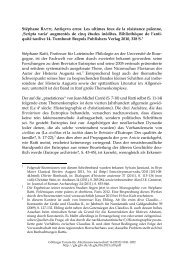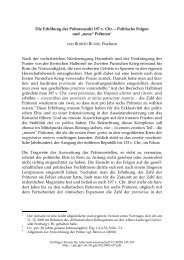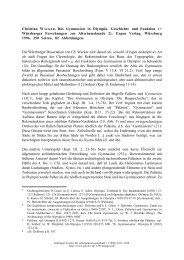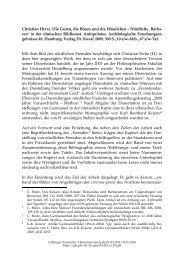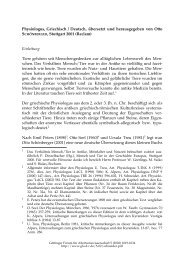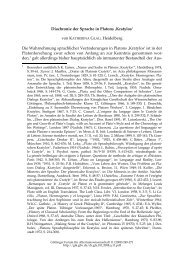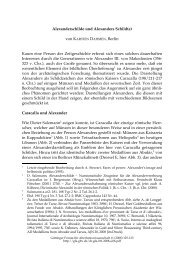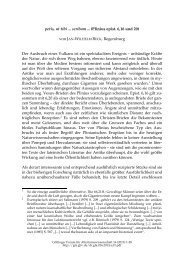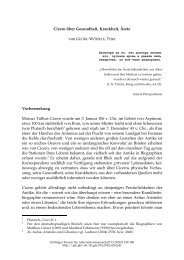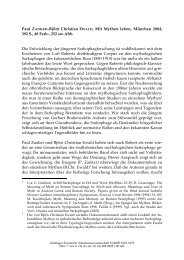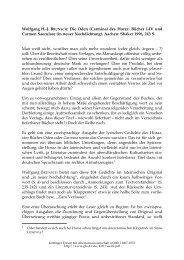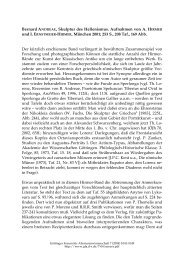The Bee Simile - Göttinger Forum für Altertumswissenschaft
The Bee Simile - Göttinger Forum für Altertumswissenschaft
The Bee Simile - Göttinger Forum für Altertumswissenschaft
Create successful ePaper yourself
Turn your PDF publications into a flip-book with our unique Google optimized e-Paper software.
148 Wolfgang Polleichtner<br />
fore). Secondly, the simile recalls the bee simile in Iliad 12.167-170. 219 Asius<br />
used the picture of bees under attack in their hive to portray how the Achaeans<br />
defended the gate of their fortress at the beach. 220 This simile is in one respect<br />
incorrect. <strong>The</strong>re are no children in the Greek camp. But there is also an<br />
allusion to the simile in book 2 of Apollonius’ poem. 221 In Vergil, the simile is a<br />
blend of what his two predecessors did with it. <strong>The</strong> Latins maintain the defense<br />
of their city as the Greeks did in Homer and ultimately do not flee unlike<br />
the Bebrycians in Apollonius. 222 <strong>The</strong>y are indeed fighting for their city and the<br />
young children that supposedly are in it even if Vergil does not explicitly say<br />
as much anywhere in the proximity of the simile itself. 223 However, the comparison<br />
between the beehive in a rock and the city which has walls built out of<br />
stone is manifest again. <strong>The</strong> city is on the brink of destruction, the Latin bees<br />
on the brink of fleeing the beekeeper’s smoke. <strong>The</strong> disaster is avoided by the<br />
fact that the Latins and their allies urge Turnus into direct combat with<br />
Aeneas. <strong>The</strong> Trojans have indeed figuratively smoked him out. <strong>The</strong>re is fire in<br />
12.573, 576, and 596. In 12.672 ff. a tower that Turnus had built himself is on<br />
fire. 224<br />
219 G.N. Knauer (1979) 429 thinks that Vergil’s changes of the bee simile in regard to its<br />
equivalents in books 2 and 12 of the Iliad are quite significant. M. Hügi (1952) 49f.; 105 n.<br />
3, claims that Apollonius’ second bee simile and Vergil’s third bee simile have no Homeric<br />
precedent; cf. H. Faerber (1932) 40f. <strong>The</strong> opposite view is held by H.-P.<br />
Drögemüller (1956) 219.<br />
220 It is interesting to note that J.H. Voß (1997) thinks that this nest is built in a rock as well;<br />
cf. his translation ad loc.<br />
221 Cf. M. von Albrecht (1966) 567; W.W. Briggs (1974) 302f.; E. Paratore (1983) 246; D. Nelis<br />
(2001) 481. M. Hügi (1952) 29 (cf. loc. cit. 49) claims that Vergil transfers human emotions<br />
to bees and thereby does something that was not done by Apollonius. I would tone this<br />
down a little bit and say that Vergil refines what was begun in Homer (Iliad 12) and further<br />
developed in Apollonius (Argonautica 2). One must also take into account that the<br />
similes serve different purposes. <strong>The</strong> Bebrycians flee quickly, while the Latins are split on<br />
how to handle the situation and finally send out Turnus and survive; cf. M. Hügi (1952)<br />
49f. Also cf. on the Homeric simile M. Coofey (1957) 132: “<strong>The</strong> simile also illustrates temporary<br />
and permanent psychological traits”.<br />
222 This has been recognized as fundamental difference between these two Apollonian and<br />
Vergilian similes by D. West (1970) 267.<br />
223 W.W. Briggs (1981) 971 points to the difference between the Bebrycians and the Latins.<br />
<strong>The</strong> latter are trapped, the former flee.<br />
224 In contrast to the Aeneid there is no fire during the battle between the Argonauts and Bebrycians<br />
in Apollonius that would create smoke and therefore make the simile correspond<br />
more closely to the narrative. Vergil has picked up a detail of the Apollonian simile<br />
and incorporated it into his narrative. Thus, Vergil proceeds with the Apollonian<br />
model just as with Homeric similes; cf. D. West (1970) 264 and 267. However, there is also<br />
the Homeric model behind the Apollonian simile even if Apollonius altered it considerably<br />
more than Vergil changed what he found in Apollonius.





